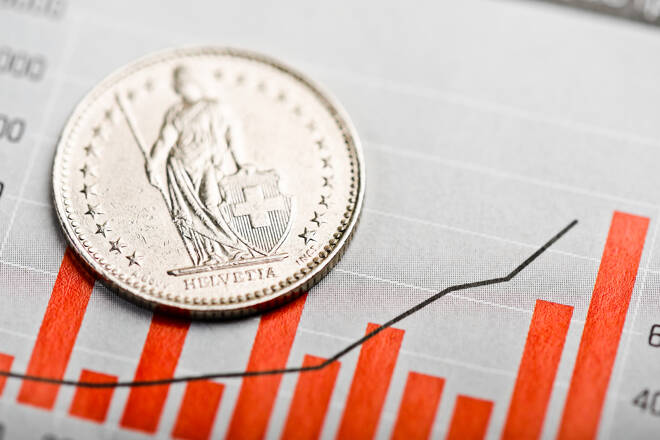Advertisement
Advertisement
The Story for the Swissie
By:
From a fundamental perspective, odds are in favor of a stronger Swiss franc.
Professional forecasters and central banks have been surprised by the persistence of rising prices, with the latter rapidly shifting their forward guidance. The Swiss National Bank (SNB) has just announced a policy normalization, surprising markets with a 50-basis point hike. What will this mean for the Swiss franc?
In short: 2022 has given investors a lot to chew on. But among many developments of this year, one really stands out; It’s inflation and the impact that high inflation has had on central bank policy. The USDCHF, known as the Swissie, rose to multi-month highs, briefly crossing above parity because of rising yields in the US, but fell nearly 3% after an unexpected 50bps rate hike from the SNB. Similarly, EURCHF which received a boost from the ECB early in the month, slid more than 2% to retest its previous support level.
From a fundamental perspective, odds are in favor of a stronger Swiss franc. EURCHF weakness is set to continue despite ECB’s policy normalisation as the risks of an economic slowdown in the Old Continent are rising. And though the war in Ukraine is weighing on the CHF against the USD, we expect the Swissie to ultimately mean revert, as we expect inflation to start cooling off in the US, removing pressure on the Fed to pursue its aggressive policy.
FX markets vs Equity markets
Geopolitical tensions and concerns about stagflation have dominated financial markets this year, pushing investors away from riskier assets. The EURCHF was tracking the underperformance of the German DAX index compared to the more defensive Swiss SMI index for much of the past year, with the pair trading at one point near parity.
But recently, even as risk appetite is back in the markets, the EURCHF is on the fall as the SNB didn’t show hesitance to firmly raise rates by 50bps. Why is the SNB not worried about a stronger CHF? On one hand, the high level of inflation in the Eurozone compared to inflation in Switzerland reduces the negative impact of a stronger CHF, taking off pressure on the Swiss National Bank (SNB) to intervene heavily in the FX market.
On the other hand, a rapid appreciation of the EUR against the CHF would undermine SNB’s price stability mandate, the reason why the governor of the SNB announced similar plans (if not more bullish), challenging speculative bets on a stronger EUR against the CHF.
ECB’s policy normalisation is positive for the euro, but not enough. Now that the war is escalating, with Russia cutting off gas supplies and the EU agreeing on a partial ban on Russian oil imports, the risks of higher for longer EU inflation have increased.
European consumers saw inflation (CPI) increase by 8% in May, and European producers saw input prices surge close to 37% year-over-year. These record numbers put enormous pressure on ECB to raise rates significantly to lower the burden of imported inflation. The current market pricing for the ECB terminal rate stands at 1.76%.
This implies ECB’s expected tightening policy is around 0.30% above the neutral rate (estimated at 1.5%). Historically, that has not been enough. In the early 90s, the Banque De France pushed 5-year French government bond yields more than 200bps above the prevailing levels of neutral nominal rates to avoid the de-anchoring of inflation expectations. Should the ECB find itself in such a situation, this significantly increases the risk of a recession in the eurozone and consequently the risk of a weaker EUR.
The battle between the bulls and bears
A terrific chart setup does not always require fancy lines, zones, and indicators. Looking at the USDCHF graph, the sentiment was quite bullish for the USDCHF in the second quarter of 2021, period during which USDCHF briefly broke above parity driven by higher real yields in the US. Though recently, dollar bulls seem caught by surprise. The pair fell almost 3% when the SNB announced a shocking but robust 50bps rate hike, squeezing short bets on the Swiss franc.
Lately, the price is oscillating around 0.9650 just below the 0.50 Fibonacci retracement level (0.97), suggesting an intense ongoing battle between the bulls and bears. Any move above or below is likely to signal the beginning of another trend in the pair.
However, traders need to be cautious of the bearish trend of the dollar. From a longer-term picture, the Swiss franc remains cheap versus the dollar as Switzerland has consistently had a current account surplus of roughly 8% of GDP, way above the level of deficits that the US government has reported for decades.
In addition, after rocketing higher over the past year, economists do expect US inflation to moderate for the rest of 2022. We’re seeing encouraging signs that some of the worst disruptions to supply chains are easing, the cost of freight is declining, many retailers are now reporting plenty of inventory, and market-based estimates of future inflation have been declining in the US.
If this trend of moderating inflation can hold, this would remove the market’s fear of an extreme 1970s-style scenario, and hence reduce pressure on the Fed to pursue a very aggressive policy, something that is starting to be priced in by Treasuries as yields on the 10-years US government bonds are pulling back from June highs.
About the Author
Esty Dwekcontributor
As a member of the Executive Committee and FlowBank's Chief Investment Officer (CIO), Esty is responsible for the investment strategy of the Bank. She also heads the Market Research department and plays a key role in developing the bank's educational offerings, among other things. She is also in charge of the Bank’s product offering.
Advertisement
